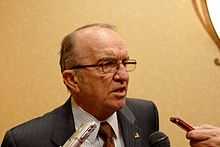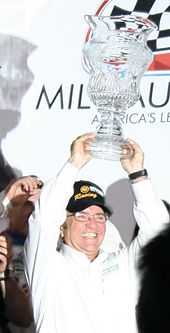Jack Roush
| Jack Roush | |
|---|---|
 | |
| Born |
April 19, 1942 Covington, Kentucky, United States |
| Nationality | United States |
| Occupation | NASCAR team owner |
Jack Roush (born April 19, 1942) is the founder, CEO, and co-owner of Roush Fenway Racing, a NASCAR team headquartered in Concord, North Carolina, and is Chairman of the Board of Roush Enterprises.
Roush Enterprises is the parent company for Roush Racing as well as Roush Industries, a freelance engineering firm; Roush Performance, an automotive aftermarket development company; and ROUSH CleanTech, a manufacturer of propane autogas fuel systems, all headquartered in Livonia, Michigan. His companies employ more than 2,000 people throughout North America and Europe.
Rarely seen without his trademark Panama hat, Roush is known on the NASCAR circuit as "The Cat in the Hat".
Roush was inducted into the International Motorsports Hall of Fame on April 27, 2006.[1] In 2008, Roush was elected to the Michigan Sports Hall of Fame and will be inducted on Sept. 13, 2010, in Novi.[1]
Early years


Throughout much of his career Roush offered for sale the parts that he developed for his own team. In 1982, he partnered with German firm Zakspeed to develop road racing vehicles for Ford. This led to a very successful run in the Trans-Am series and IMSA Camel GT in the 80s and early 90s. In 1988, Roush moved south and founded a NASCAR Sprint Cup team now called Roush Fenway Racing with driver Mark Martin.
NASCAR
Roush Fenway Racing currently fields three cars in the NASCAR Sprint Cup Series (driven by Ricky Stenhouse, Jr., Greg Biffle and Carl Edwards), and three cars in the NASCAR Nationwide Series (driven by Travis Pastrana, Trevor Bayne,and a part-time car for Chris Buescher.) Jack Roush has won 7 championships as a car owner in NASCAR's top 3 series. 2 Sprint Cup titles (2003 with Matt Kenseth and 2004 with Kurt Busch), 4 Nationwide Series titles (2002 with Greg Biffle, 2007 with Carl Edwards and 2011-2012 with Ricky Stenhouse Jr. ) and a Camping World Truck Series title in 2000 with driver Greg Biffle. Jack has 2 Daytona 500 victories as a car owner, both with driver Matt Kenseth in 2009 and 2012. Since Jack entered NASCAR competition his team has 283 wins and 212 poles.[2]
Roush Performance

The company has a line of more than 1,500 high-performance parts that fit a variety of vehicles including the Mustang, F-150, Focus and others. The crate engines can be customized per owner preference and are the choice of many hot rod and Cobra replicar builders such as Chip Foose, Roy Brizio, and Superformance.
ROUSH CleanTech

Roush has expanded into offering propane-autogas-fueled vehicles designed for fleet usage. [4] The company product offerings include propane autogas fuel system technology for light light- and medium-duty Ford commercial vehicles, and Type A and Type C Blue Bird Corporation school buses. Most vehicle kits offer multiple tank configurations.
Propane autogas is a domestically produced alternative fuel which costs less than conventional fuels. Over the past 30 years, propane autogas has cost, on average, 30 percent less than gasoline and 40 percent less than diesel. More than 90 percent is produced in the U.S. (and an additional 7 percent from Canada), which lessens American dependency on foreign oil. The fuel burns substantially cleaner than gasoline or diesel. ROUSH CleanTech's propane-autogas-fueled vehicles have the same horsepower, torque and towing capacity as their gasoline-powered equivalent so there is no loss of vehicle functionality. Ford's factory warranty remains intact on the ROUSH CleanTech vehicles.
Across the nation, companies such as DISH, SuperShuttle, ThyssenKrupp Elevator and hundreds of school districts have experienced reduced fuel and operating costs while lowering their carbon footprint with propane autogas vehicles.[5]
Plane crashes
On April 20, 2002, Roush almost lost his life when his private plane, an Aircam, went down in a lake in Troy, Alabama. Roush was underwater and unconscious, suffering from a head concussion, when Larry Hicks, a retired Marine in a nearby boat, rescued Roush from under water, pulled him to safety, and administered CPR. Shortly afterwards, Roush was flown to UAB Hospital in Birmingham, Alabama where he was treated for a head injury, broken ribs, and a shattered left leg. Hicks was injured as a result of the rescue, suffering cramps in both his arms and first degree chemical burns on his body from the fuel.[6]
On July 27, 2010, Roush crash-landed in his Hawker Beechcraft Premier 390 jet, (registration N6JR,) during an approach to the Experimental Aircraft Association (EAA) AirVenture Fly-In in Oshkosh, Wisconsin in the late afternoon.[7] He walked out of the plane and was taken to a nearby hospital.[8] His condition was listed at serious but stable that evening. On August 3, Roush was upgraded to fair condition.[8] On August 13, Roush made his first at track appearance since the incident at the Michigan International Speedway. During that time he confirmed that he fractured his back, broke his jaw, and lost his left eye as a result.[9] The National Transportation Safety Board attributed the cause of the crash to pilot error, specifically, "pilot's decision not to advance the engines to takeoff power during the go-around, as stipulated by the airplane flight manual, which resulted in an aerodynamic stall at a low altitude."[10]
References
- ↑ "Jack Roush at the International Motorsports Hal of Fame".
- ↑ "Jack Roush Bio at RoushFenway.".
- ↑ "Roush Performance about page".
- ↑ "ROUSH CleanTech: Three years of steady growth, Green Fleet magazine, January 6, 2014".
- ↑ "School buses go green with eco friendly propane fuel, USA Today, August 11, 2013".
- ↑ "Ford Jack Roush Update".
- ↑ "Jack Roush Crashes Plane In Wisconsin".
- ↑ 8.0 8.1 Bromberg, Nick (July 28, 2010). "Jack Roush injured in plane crash in Wisconsin". Yahoo! Sports. Retrieved 28 July 2010.
- ↑ "Roush returns to track bearing scars from crash".
- ↑ "NTSB Report".
| ||||||||||||||||||||||||||||||||||||